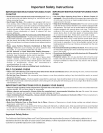
Surface Cooking
Using proper cookware
The size and type of cookware used will influence the setting
needed for best cooking results. Cookware should have flat
bottoms that make good contact with the entire surface heating
element (See Fig. 1). Check for flatness by rotating a ruler across
the bottom of the cookware (See Fig. 2).
Cookware Material Types
The cookware material determines how evenly and quickly heat is
transferred from the surface element to the pan bottom. The most
popular materials available are:
ALUMINUM =Excellent heat conductor. Some types of food will
cause it to darken (Anodized aluminum cookware resists staining
& pitting), if aluminum pans slide across the ceramic cooktop,
they may leave metal marks which will resemble scratches.
Remove these marks immediately.
COPPER =Excellent heat conductor but discolors easily. May
leave metal marks on ceramic glass (see Aluminum above).
STAINLESS STEEL- Slow heat conductor with uneven cooking
results. Is durable, easy to clean and resists staining.
CAST iRON =A poor heat conductor however will retain heat very
well. Cooks evenly once cooking temperature is reached. Not
recommended for use on ceramic cooktops.
PORCELAiN=ENAMEL on METAL =Heating characteristics will
vary depending on base material. Porcelain-enamel coating must
be smooth to avoid scratching ceramic cooktops.
GLASS- Slow heat conductor. Not recommended for ceramic
cooktop surfaces because it may scratch the glass.
CORRECT
W
• Flat bottom and straight
sides.
• Tight fitting lids.
• Weight of handle does not
tilt pan. Pan is well
balanced.
e Pan sizes match the
amount of food to be
prepared and the size of
the surface element.
o Made of a material that
conducts heat well,
• Easy to clean.
e Always match pot diameter
to surface element
diameter.
Fig. 1
Be sure to follow the
recommendations for
using proper
cookware as
illustrated in Figs. 1 &
2. For more
informationaboutthe
ceramic cooktop see
"Cooktop Cleaning &
Maintenance" inthe
General Care &
Cleaning section.
iNCORRECT
• Curved and warped pan
bottoms,
o Pan overhangs element by
more than one-half inch.
e Pan is smaller than
element.
® Heavy handle tilts pan.
Fig. 2


















